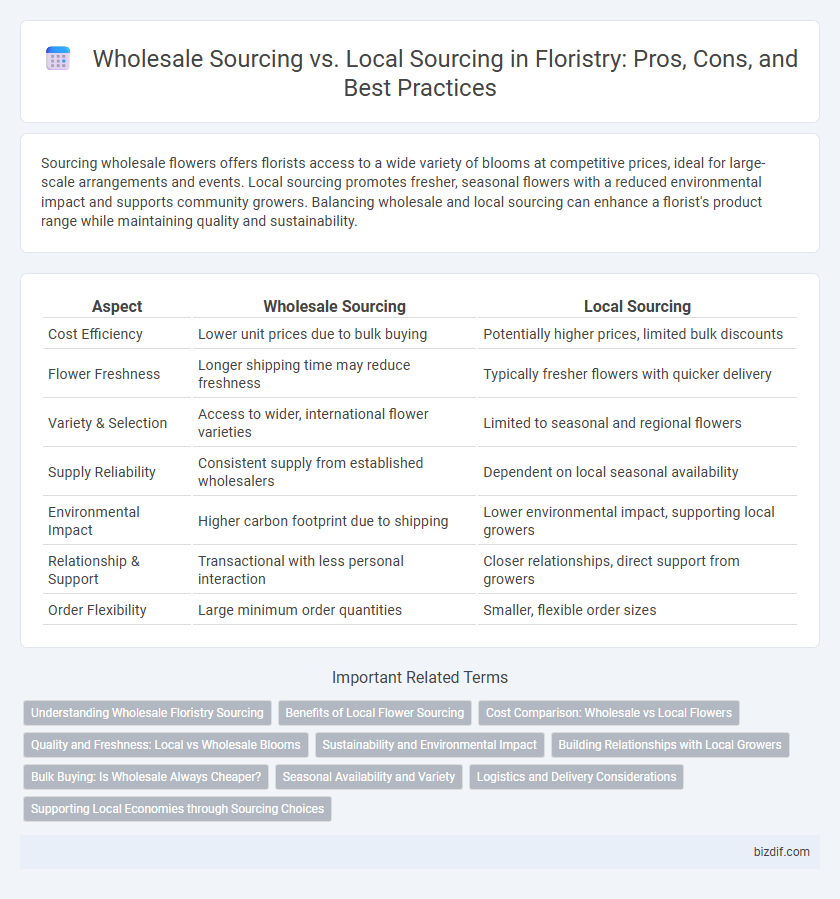Sourcing wholesale flowers offers florists access to a wide variety of blooms at competitive prices, ideal for large-scale arrangements and events. Local sourcing promotes fresher, seasonal flowers with a reduced environmental impact and supports community growers. Balancing wholesale and local sourcing can enhance a florist's product range while maintaining quality and sustainability.
Table of Comparison
| Aspect | Wholesale Sourcing | Local Sourcing |
|---|---|---|
| Cost Efficiency | Lower unit prices due to bulk buying | Potentially higher prices, limited bulk discounts |
| Flower Freshness | Longer shipping time may reduce freshness | Typically fresher flowers with quicker delivery |
| Variety & Selection | Access to wider, international flower varieties | Limited to seasonal and regional flowers |
| Supply Reliability | Consistent supply from established wholesalers | Dependent on local seasonal availability |
| Environmental Impact | Higher carbon footprint due to shipping | Lower environmental impact, supporting local growers |
| Relationship & Support | Transactional with less personal interaction | Closer relationships, direct support from growers |
| Order Flexibility | Large minimum order quantities | Smaller, flexible order sizes |
Understanding Wholesale Floristry Sourcing
Wholesale floristry sourcing offers access to a vast selection of flowers at competitive prices, ideal for businesses requiring large volumes and variety. Local sourcing emphasizes freshness and supporting nearby growers, enhancing sustainability and reducing transportation time. Balancing wholesale availability with local quality can optimize inventory management and customer satisfaction in floristry.
Benefits of Local Flower Sourcing
Local flower sourcing offers fresher blooms with longer vase life due to reduced transportation time, enhancing overall product quality in floristry. Sourcing locally supports sustainable practices by minimizing carbon emissions associated with long-distance shipping and promotes the regional economy through direct partnerships with nearby growers. Florists benefit from improved supply chain reliability and the ability to access unique, seasonal varieties not available in wholesale international markets.
Cost Comparison: Wholesale vs Local Flowers
Wholesale flowers typically offer lower costs per stem due to bulk purchasing and established supply chains, resulting in significant savings for florists handling large volumes. Local flower sourcing, while often more expensive per unit, can reduce transportation costs and support seasonal, fresh, and unique varieties that enhance bouquet quality. Evaluating total cost impact requires balancing wholesale price benefits against potential premium charges and freshness advantages of locally sourced blooms.
Quality and Freshness: Local vs Wholesale Blooms
Local sourcing ensures superior freshness and vibrant blooms due to minimal transportation time, enhancing flower longevity and quality. Wholesale suppliers offer a broader variety at competitive prices, but extended shipping can compromise petal integrity and scent. Prioritizing local flowers supports sustainable practices and guarantees peak bloom freshness for premium floral arrangements.
Sustainability and Environmental Impact
Sourcing wholesale flowers often involves long-distance transportation, increasing carbon emissions and environmental footprint compared to locally sourced blooms. Local sourcing supports seasonal growth cycles and reduces the need for synthetic preservatives, enhancing sustainability in floristry practices. Emphasizing local suppliers also promotes biodiversity and strengthens community economies while minimizing waste and resource consumption.
Building Relationships with Local Growers
Building relationships with local growers enhances the quality and freshness of floral arrangements by ensuring timely access to seasonal blooms and unique varieties. Sourcing local flowers supports sustainable practices and reduces transportation costs, fostering a strong community network that benefits both florists and growers. This approach allows florists to offer personalized service and maintain consistent inventory through trusted partnerships.
Bulk Buying: Is Wholesale Always Cheaper?
Bulk buying in floristry often makes wholesale sourcing more cost-effective due to lower per-unit prices and access to larger quantities, ideal for high-demand events or shop inventory. Local sourcing, while typically pricier, offers fresher blooms and supports sustainability with reduced transportation emissions. Evaluating total costs--including freshness, quality, and delivery reliability--helps florists determine whether wholesale bulk purchases or local suppliers best meet their business needs.
Seasonal Availability and Variety
Sourcing wholesale floral supplies often provides a broader variety of blooms year-round due to global distribution networks, ensuring access to out-of-season flowers. Local sourcing emphasizes seasonal availability, offering fresher, more sustainable options that support regional growers and reduce environmental impact. Choosing local suppliers can enhance flower quality and promote unique, seasonal arrangements that resonate with community preferences.
Logistics and Delivery Considerations
Sourcing wholesale flowers often involves complex logistics, including longer shipping times and the need for climate-controlled transportation to maintain freshness. Local sourcing minimizes delivery delays and reduces transportation costs, enhancing the freshness and sustainability of floral arrangements. Reliable delivery schedules and efficient supply chain management are critical factors when balancing wholesale bulk availability against the promptness and quality of locally sourced blooms.
Supporting Local Economies through Sourcing Choices
Sourcing flowers locally strengthens community economies by supporting small-scale growers and reducing transportation emissions, which enhances sustainability. Wholesale sourcing offers competitive pricing and variety but may divert funds from local farmers, limiting economic growth within the region. Prioritizing local florists and growers promotes fair wages and preserves regional biodiversity, fostering a resilient floral supply chain.
Sourcing wholesale vs sourcing local Infographic

 bizdif.com
bizdif.com